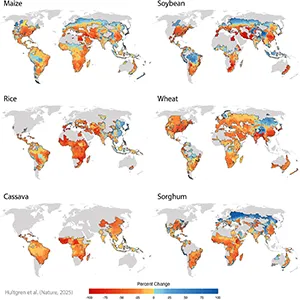TTM Acquires Wisconsin Facility, Malaysian Land Rights – Orange County Business Journal

TTM Technologies Strategic Expansion Aligned with Sustainable Development Goals
TTM Technologies Inc. has announced significant investments in its global manufacturing footprint, acquiring a major facility in the United States and land for a new site in Malaysia. These strategic actions directly support several United Nations Sustainable Development Goals (SDGs) by fostering innovation, promoting inclusive economic growth, and building resilient infrastructure.
Fostering Economic Growth and Resilient Infrastructure (SDG 8 & SDG 9)
Investment in Industrial Infrastructure and Job Creation
The company’s expansion is a direct investment in industrial capacity, contributing to economic development in multiple regions. This initiative aligns with SDG 8 (Decent Work and Economic Growth) and SDG 9 (Industry, Innovation, and Infrastructure).
- Wisconsin, USA: Acquisition of a 750,000-square-foot facility in Eau Claire. The reuse of an existing industrial site supports sustainable community development (SDG 11) by revitalizing infrastructure.
- New York, USA: Ongoing progress on a new printed circuit board (PCB) production facility in Syracuse.
- Penang, Malaysia: Acquisition of land rights for a 10-acre future manufacturing site.
These developments are poised to create skilled jobs, stimulate local economies, and build a more resilient industrial base in North America and Southeast Asia.
Advancing Technological Innovation
The new facilities are designated for the production of advanced technology PCBs, which are critical components for high-growth, innovative sectors. This focus on advanced manufacturing is a key driver for SDG 9.
- The Wisconsin facility will enhance TTM’s capacity for high-volume U.S. production, specifically targeting the data center computing and networking markets essential for generative artificial intelligence (AI) applications.
- The future Penang facility will support similar advanced commercial markets, including data center computing, networking, and medical instrumentation.
Enhancing Supply Chain Resilience and Responsible Production (SDG 9 & SDG 12)
Strategic Diversification for Global Resilience
A core objective of the expansion is to diversify TTM’s manufacturing operations beyond China, a strategy that enhances supply chain security and resilience. This aligns with SDG 9’s target to build resilient infrastructure and SDG 12’s principles of responsible production patterns.
- The company aims to provide “regionally optimized, globally connected manufacturing solutions,” reducing reliance on a single geographic area.
- This diversification offers customers greater flexibility and supply chain security, which is critical for stable global commerce.
Financial Strength Enabling Sustainable Investment
TTM’s robust financial performance provides the foundation for these strategic investments in sustainable industrial development. The company reported a 14% year-over-year revenue increase in Q1 to $648.7 million, with its market capitalization reaching $4.7 billion. This financial health enables TTM to pursue long-term growth strategies that contribute positively to global economic and technological goals.
SDGs Addressed in the Article
SDG 3: Good Health and Well-being
- The article mentions that TTM Technologies produces printed circuit boards for “medical devices” and that its future facility in Penang, Malaysia, is expected to support the “medical” market. This directly links the company’s industrial activities to the healthcare sector, which is central to SDG 3.
SDG 8: Decent Work and Economic Growth
- The article highlights significant economic activity, including company expansion through the acquisition of facilities in the U.S. and land in Malaysia. It also reports substantial financial growth, with a “14% increase year over year” in Q1 revenue and a stock value that has “more than doubled since May.” This expansion implies job creation and contributes to economic growth in the regions where TTM operates.
SDG 9: Industry, Innovation, and Infrastructure
- This goal is central to the article. TTM Technologies is a key player in the technology industry, manufacturing “technologically advanced printed circuit boards.” The company is actively building and upgrading industrial infrastructure by acquiring a “750,000-square-foot facility in Eau Claire, Wisconsin,” progressing on a “new printed circuit board production facility in Syracuse, New York,” and securing land for a “new production site” in Penang, Malaysia. The products support critical modern infrastructure, including “data center computing and networking for generative artificial intelligence (AI) applications.”
SDG 11: Sustainable Cities and Communities
- By investing in large-scale manufacturing facilities in specific urban locations such as “Eau Claire, Wisconsin,” “Syracuse, New York,” and “Penang, Malaysia,” TTM Technologies contributes to local economic development. These investments create jobs and foster industrial activity, strengthening the economic base of these communities.
Specific Targets Identified
SDG 8: Decent Work and Economic Growth
- Target 8.1: Sustain per capita economic growth. The article provides evidence of TTM’s contribution to economic growth through its reported “Q1 revenue of $648.7 million, a 14% increase year over year” and its market capitalization of “$4.7 billion.”
- Target 8.2: Achieve higher levels of economic productivity through diversification, technological upgrading and innovation. The company’s strategy to diversify its supply chain “beyond China” by investing in the U.S. and Malaysia, and its focus on producing “advanced technology PCBs” for “generative artificial intelligence (AI) applications,” directly align with this target.
SDG 9: Industry, Innovation, and Infrastructure
- Target 9.2: Promote inclusive and sustainable industrialization. The expansion of manufacturing capacity through new and acquired facilities in Wisconsin, New York, and Malaysia directly contributes to industrialization and increases the industry’s share of the economy in those regions.
- Target 9.4: Upgrade infrastructure and retrofit industries to make them sustainable. The development of new facilities to produce “advanced technology PCBs” represents an upgrade of industrial infrastructure to support modern, high-tech sectors like AI and data centers.
- Target 9.b: Support domestic technology development, research and innovation in developing countries. The acquisition of land in “Penang to establish a new production site” is a direct investment that supports Malaysia’s industrial and technological capacity.
SDG 11: Sustainable Cities and Communities
- Target 11.a: Support positive economic, social and environmental links between urban, peri-urban and rural areas. The establishment of major industrial sites in “Eau Claire,” “Syracuse,” and “Penang” strengthens regional development by creating economic activity and employment, fostering positive economic links within these communities.
Indicators for Measuring Progress
SDG 3: Good Health and Well-being
- Implied Indicator: Production and supply of components for the medical device industry. The article states TTM makes parts for “medical devices” and will support the “medical” market, indicating its role in the healthcare supply chain.
SDG 8: Decent Work and Economic Growth
- Indicator: Year-over-year revenue growth. The article explicitly states a “14% increase year over year” in Q1 revenue.
- Indicator: Increase in company market value. The article notes a “market cap of $4.7 billion” and that the stock has “more than doubled since May.”
- Indicator: Geographic diversification of manufacturing facilities. The investments in Wisconsin, New York, and Malaysia are mentioned as part of a strategy to diversify “beyond China.”
SDG 9: Industry, Innovation, and Infrastructure
- Indicator: Investment in new industrial infrastructure. This is measured by the acquisition of a “750,000-square-foot facility,” progress on a “new printed circuit board production facility,” and the acquisition of “land rights for 10 acres.”
- Indicator: Production of advanced technology components. The article specifies the manufacturing of “advanced technology PCBs” for “generative artificial intelligence (AI) applications.”
- Indicator: Foreign direct investment in industrial capacity in developing countries. The plan to “establish a new production site” in Penang, Malaysia, serves as a direct indicator.
Summary Table of SDGs, Targets, and Indicators
| SDGs | Targets | Indicators |
|---|---|---|
| SDG 3: Good Health and Well-being | Support for the health industry through technology. | Production of components for “medical devices” and support for the “medical” market. |
| SDG 8: Decent Work and Economic Growth | 8.1: Sustain per capita economic growth. | Reported revenue of “$648.7 million, a 14% increase year over year” and a “$4.7 billion” market cap. |
| 8.2: Achieve higher levels of economic productivity through diversification and technological upgrading. | Diversification of manufacturing to the U.S. and Malaysia; focus on “advanced technology PCBs” for “AI applications.” | |
| SDG 9: Industry, Innovation, and Infrastructure | 9.2: Promote inclusive and sustainable industrialization. | Acquisition and development of manufacturing facilities in Wisconsin, New York, and Malaysia. |
| 9.4: Upgrade infrastructure and retrofit industries. | Development of new facilities to support “generative artificial intelligence (AI) applications.” | |
| 9.b: Support domestic technology development in developing countries. | Establishment of a “new production site” in Penang, Malaysia. | |
| SDG 11: Sustainable Cities and Communities | 11.a: Support positive economic links between urban, peri-urban and rural areas. | Investment in large industrial facilities in specific cities: “Eau Claire, Wisconsin,” “Syracuse, New York,” and “Penang, Malaysia.” |
Source: ocbj.com

What is Your Reaction?
 Like
0
Like
0
 Dislike
0
Dislike
0
 Love
0
Love
0
 Funny
0
Funny
0
 Angry
0
Angry
0
 Sad
0
Sad
0
 Wow
0
Wow
0












































































